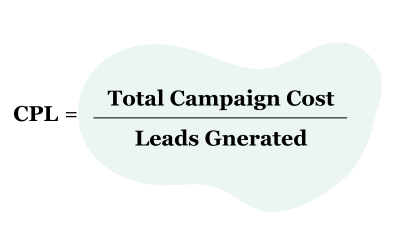- SEO
SEO Agency
Take advantage of the first traffic acquisition lever by entrusting your SEO to a digital agency experienced in SEO. - SEA
SEA Agency
Grow your business quickly with paid search (SEA).
- Social Ads
Social ads
Optimize your social media advertising campaigns to improve your performance.TikTok adsGo viral with your ads on TikTok

- Agency
The agency
Keyweo was born from the desire to create an agency that meets the principles of transparency, trust, experience and performance.
- Blog
- Contact
CPL: Cost Per Lead
Home > SEA Agency > SEA Glossary > CPL (Cost Per Lead)
Definition
CPL, or Cost Per Lead, is a metric used in digital marketing to measure the cost it takes to generate leads through a marketing or advertising campaign. It is also known as a key performance indicator (KPI). A lead is classified as a potential customer who has expressed interest in a business’s product/service. This “interest” could be the action of filling out an application form, requesting a demo, registering for a course, or signing up for a newsletter.
It is a useful indicator in industries where purchases may not always be immediate. For example, in the car industry. Potential customers won’t buy a car outright. They will arrange to meet with a salesman or book a test drive. This digital marketing metric is an excellent tool that helps marketers understand how effective their campaigns are at turning interest into actionable leads, enabling them to manage costs, improve their conversion rate, and allocate budgets efficiently.

Quick Access
How to Calculate CPL?
Formula
It is easy to calculate CPL. The only figures that you need are the total amount spent on an advertising campaign and the number of leads generated as a result of this campaign, all within a given period. Divide the former by the latter to get your cost per lead. Here is a visual of this formula for you.
Example

Let’s put this formula into a real-life perspective. Imagine a car dealership sets up an online advertising campaign that lasts 1 month. The campaign costs €4,000. During this time, the car dealership receives 200 test drive requests (leads). The CPL is then calculated as:

What is a Good CPL?
How good a CPL is will depend on several factors. The pricing model varies by industry, target audience, and business model. For example, a lead in the B2B tech industry might cost significantly more than a lead in the retail or hospitality sector. A good CPL should align with your customer lifetime value (CLV) and the profit margin of the products or services offered.
- Low-cost leads are desirable, but not at the expense of quality. Cheap leads that don’t convert will cost your business more in the long run.
- Benchmarking against industry standards and previous advertising campaigns can help determine if your CPL is competitive or classified as a “good” CPL.
What is a Bad CPL?
A bad CPL is one that is too high in relation to the quality of the leads generated or the revenue they can bring in. If your CPL exceeds the revenue you earn from each lead, your campaign is considered inefficient.
A high CPL could signal that the campaign is either reaching the wrong audience, the ad creatives aren’t effective, or the landing pages aren’t converting well. In some cases, it indicates that the channels or platforms being used are too expensive for the type of leads being generated.
It’s important to regularly monitor and analyse CPL to avoid overspending on low-quality leads. A bad CPL often points to the need for campaign optimisation and strategy adjustments.

Differences between CPL and CPA
While both CPL and CPA (Cost Per Acquisition) are used to measure the cost of acquiring customers, the key difference lies in the end goal:
- CPL measures the cost per lead, which refers to generating interest or inquiry from potential customers, e.g. a newsletter sign up.
- CPA measures the cost per actual conversion or acquisition, e.g., a completed sale of a car.
CPL focuses on the early stages of the customer journey, while CPA tracks the latter stages, when a lead converts into a paying customer. Businesses can use both metrics to assess and refine their marketing strategies, ensuring they are generating leads at a cost-effective rate while also ensuring those leads convert into sales.
| CPL (Cost Per Lead) | CPA (Cost Per Acquisition) | |
|---|---|---|
| Definition | Cost incurred for generating a lead, such as a form submission or sign-up. | Cost incurred when a specific action is completed, such as making a purchase. |
| Payment Basis | Advertiser pays for each lead generated regardless of whether the lead converts to a sale. | Advertiser pays only when a lead converts into a paying customer or completes the desired action. |
| Goal | To generate as many qualified leads as possible, often to nurture into customers. | To drive conversions by ensuring leads become paying customers or achieve the desired action. |
| Use Case | B2B services, real estate, or car dealerships. | E-commerce or subscription services. |
Best Practices for CPL Optimisation
Optimise Target Audience
Focus your advertising efforts on targeting the right demographic. Using audience segmentation based on behaviour, interests, and past interactions with your brand will help ensure you’re attracting leads that are more likely to convert.
Refine Your Ad Creatives
Craft ads that effectively communicate the value proposition and call to action. Experiment with different ad formats, copy, and images to see which receive the best reaction from your audience. A strong offer and clear message can improve conversion rates and lower CPL.
Use High-Performing Channels
Test and evaluate different marketing channels to determine where you can generate the best quality leads at the lowest cost. Channels like Google Ads, Facebook Ads, LinkedIn, and others all have their pricing models and audience targeting options. Track which channel provides the best ROI (return on investment).

A/B Test Advertising Campaigns
A/B testing is useful for identifying which aspects of your campaigns are most effective. By testing variations of your ads, landing pages, and other elements (like forms or offers), you can spot the changes that will yield the best results and improve your CPL. Constant testing and optimisation will help fine-tune your approach over time, driving better conversions at a lower cost.
Use Retargeting Ads
Retarget visitors who have already shown interest in your offerings but have not yet converted. Retargeting can reduce CPL by keeping your brand top of mind and increasing the chances of conversion without needing to spend on new audiences.
Improve Landing Pages
Your landing page plays a big role in converting website visitors into leads. Ensure your landing page is user-friendly, loads quickly, and has a clear, concise form. The simpler and more satisfying your landing page is, the more likely site visitors are to take the desired action.
Conclusion
Cost Per Lead (CPL) is an important pricing model that helps businesses understand the efficiency of their lead generation efforts. By analysing CPL, businesses can evaluate how well their advertising campaigns are attracting qualified leads and whether they’re achieving cost-effective results.
However, always remember that a low CPL doesn’t always equal success. The quality of the leads is just as important as the cost of acquiring them. By continuously optimising your audience targeting, ad creatives, and conversion strategies, you can reduce CPL while maximising the quality and value of your leads. This enables you to allocate your advertising budget efficiently and drive better results for your business.
Most popular definitions
SERP
H1 Tag
trust flow
seo data
popularity index
link juice
alt attribute
semantic cocoon
meta description
internal mesh
robots.txt
duplicate content
Boost your Visibility
Do not hesitate to contact us for a free personalised quote
Notez ce page







